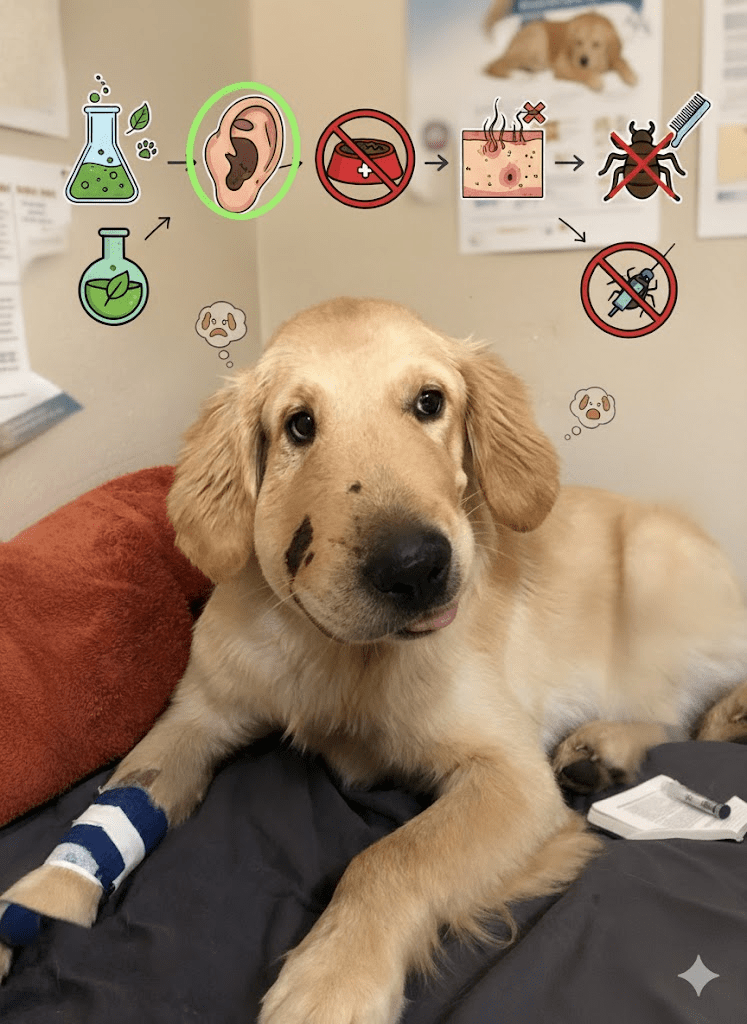Observing our beloved canine companions in distress is undoubtedly one of the most challenging experiences for any pet owner. The image before us, while endearing in its own way, serves as a poignant reminder of such a moment: a golden retriever, with a noticeably swollen muzzle and a bandaged paw, resting with a hint of vulnerability. This visual narrative immediately brings to the forefront the critical topic of allergic reactions in dogs, a common yet often alarming condition that can manifest in various ways, from mild skin irritations to severe, life-threatening responses. Understanding the nuances of canine allergies, recognizing their symptoms, and knowing how to respond are not just good practices but essential responsibilities for ensuring the health and well-being of our furry family members. This article aims to delve into the complexities of allergic reactions in dogs, providing professional, informative insights designed to empower pet owners with the knowledge and confidence to navigate these situations effectively, ultimately drawing attention to the paramount importance of early detection and appropriate veterinary intervention.

Allergies in dogs, much like in humans, occur when the immune system overreacts to a harmless substance, identifying it as a threat. These substances, known as allergens, can come in myriad forms, leading to a diverse range of allergic responses. Environmental allergens are among the most common culprits, including pollen from trees, grasses, and weeds, dust mites, and mold spores. These airborne particles can trigger seasonal allergies, presenting symptoms that often mirror hay fever in humans. Food allergies, while less prevalent than environmental ones, can also be a significant issue. In these cases, a dog’s immune system reacts adversely to specific proteins found in their diet, commonly beef, chicken, dairy, or wheat. Lastly, flea allergy dermatitis (FAD) is a widespread allergic reaction to the saliva of fleas, causing intense itching and skin irritation with even a single bite. Understanding these broad categories is the first step in identifying the potential source of your dog’s discomfort.

Allergic reactions manifest through a spectrum of symptoms, and recognizing these signs early is crucial for timely intervention. The most common indicators involve dermatological issues, such as persistent itching (pruritus), redness of the skin, hot spots (localized areas of inflammation and infection), hair loss due to excessive scratching or licking, and recurrent ear infections. Swelling, as seen in our featured golden retriever, is another prominent sign, particularly around the face, muzzle, eyelids, or ears, often indicative of an acute hypersensitivity reaction, sometimes to an insect bite or sting. Gastrointestinal symptoms like vomiting and diarrhea can also point to food allergies. In severe cases, an anaphylactic shock, though rare, can occur, characterized by sudden weakness, difficulty breathing, collapse, and pale gums, requiring immediate emergency veterinary care. A pet owner’s attentiveness to these varied symptoms plays a vital role in their dog’s diagnostic journey.

Determining the precise allergen responsible for a dog’s reaction often requires a methodical approach by a veterinarian. For environmental allergies (atopy), diagnosis typically involves ruling out other conditions first. Skin tests, similar to those used in humans, where small amounts of various allergens are injected under the skin, or blood tests (serum IgE tests) that measure antibodies to specific allergens, can help identify the culprits. Food allergies are diagnosed through an elimination diet trial, where the dog is fed a novel protein or hydrolyzed protein diet for several weeks to see if symptoms resolve, followed by reintroducing old foods one by one to pinpoint the allergen. Flea allergy dermatitis is usually diagnosed based on the presence of fleas or flea dirt and the characteristic pattern of itching and skin lesions. An accurate diagnosis is paramount as it guides the most effective treatment plan.







